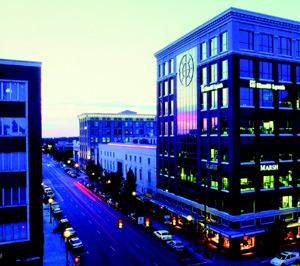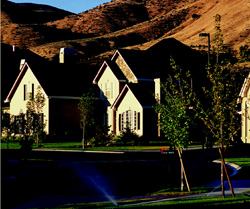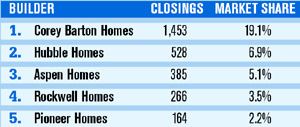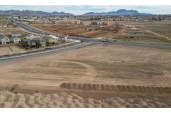Somewhere between the foothills and the farmland, Boise rambles, rolls, and races to the horizon. But, so far, there’s nothing stopping this burgeoning capital city’s inevitable gold rush. Not the flood of newcomers flocking in for a flourishing job market. Not the waves of investors hunting for homes in its recreation-rich setting. And certainly not the shortage of land.
Once upon a time, Idaho may have been nothing more than the sleepy homestead of potato farmers and ranchers. Now, the state—the nation’s third-fastest-growing—is shedding its image as the West Coast’s “quiet corner.”
An unprecedented building boom has swept throughout the Treasure Valley, home to a half-dozen fast-growing cities including Boise, Meridian, Nampa, and Caldwell. And while it’s dominated by smaller local builders today, analyst Stanley Duobinis, president of Millersville, Md.-based Crystal Ball Economics, says the expanding metropolis has just what it takes to entice the big guys.
“I call it ‘California without the ocean,’” says Duobinis, who forecasts up-and-coming housing markets. “Boise has been and will be a pretty strong market.”
Local builders claim that big builders—D.R. Horton, for one—are already blazing inroads into Boise, quietly amassing holdings and acreage. While no foundations have yet been laid by any national builders, many believe the wave’s crest will break any day now.
“National builders haven’t been in Boise before because the margins weren’t enough to make it pencil for the big builders,” says David Hale, president of Boise-based Hale Development, which specializes in the city’s expanding infill market. “Last year, we heard the first national builder was coming, but there’s no product yet. This [2005] is the year that Boise got put on the map.”
“Unfortunately, we can’t comment on a market until we’ve gone vertical,” says Shannon Farrell, communications coordinator for D.R. Horton. “We don’t count a market until we’ve got houses going up.”
YOU SAY POTATOES… On paper, Boise and its surrounding locales couldn’t look better. The area’s population has nearly doubled over the past decade, growing an average of about 4 percent a year, buoyed by a blossoming job market that economists and city leaders say will continue its upward march. Last year, Forbes Magazine named Boise the top place in the nation to do business and pursue a career. With large numbers of educated workers and relatively low costs of doing business, the area has lured such high-tech companies as Intel, Hewlett-Packard, and Compaq, while creating a groundswell of government jobs and careers in health care and education.
“One of the big advantages of the mountain state cities is the fact that they have a good mid-level employment base without the congestion and costs of operating in a big city,” Duobinis says. “Similar to Salt Lake City, Denver, and Phoenix, Boise has enjoyed a good market for manufacturing circuitry because of its dry climate.”
Like other once-overlooked Western regions, the Boise area has benefited from the flight of Californians to more affordable neighboring states. At the end of 2005, the Boise area relished a record low unemployment rate of 3.3 percent—lower than the national average of 4.9 percent—and added 8,900 jobs in one year, a 3.6 percent growth rate that promises to continue, according to Hanley Wood Market Intelligence (HWMI). In addition, Boise-area residents reap higher paychecks than the national average, with a median income of $46,140, according to the Ida-ho Department of Commerce and Labor.
Despite decreasing affordability over the past couple of years, housing prices in Boise’s Ada County and neighboring Canyon County remain a bargain. By the end of 2004, the median existing home price in the Boise metro area climbed 4 percent, from $130,600 to $135,900 for single-family detached homes, according to HWMI. Those figures, coupled with another promising statistic—soaring numbers of young people—mean that record numbers of people should be buying homes over the coming years, according to Philip Hopkins, managing director of U.S. Regional Services for Global Insight. By 2010, nearly 31 percent of Boise’s population will be between the ages of 25 and 44—prime home buying years—according Hopkins’ projections.
“A lot of people have discovered Ida-ho,” says Chris Mooney, executive officer for the Ada County Association of Realtors. “Especially as it relates to Seattle, Portland, and Spokane, we’re a much better buy.”
WANT A PIECE? JOIN THE CLUB While the Boise area has yet to see many big national builders, local companies and officials have long known that the explosion is just over the horizon.
Indeed, last year was Boise’s best building year in the past five, says Jenifer Gilliland, the city building division manager. The city issued 953 permits for single-family dwellings and a total of 16,564 overall building permits, which include multifamily units and a surge in various types of infill.
“We’ve been booming almost nonstop for the past 10 years, so things are definitely going on here,” Gilliland says. “We’re seeing that some of the new housing [is] getting more expensive.”
But, as building officials throughout Southwestern Idaho note, the real growth is in Boise’s suburbs, where Gilliland says, the residential surge is “going gang-busters.”
In bedroom communities like Meridian, Nampa, and Caldwell—all of which are within a few miles of Boise—building officials report record-breaking numbers of permits issued in 2005. According to HWMI, building permits issued throughout the region, which includes five counties and the city of Boise, increased by 14 percent in 2004 to a total of 8,895 for both single-family and multifamily homes. For 2005, HWMI expects permits for single-family dwellings in that area alone to have risen to 9,337, up from 7,843 at the end of 2004.
Most of the new homes outside Boise are taking root in sprawling 100-plus-acre subdivisions, replacing former farmland and selling out before the projects have broken ground. The hottest products at the moment are low-density, single-family detached homes in large, planned communities, says Dennis Davis, building official for the City of Nampa, about 20 miles away. At the moment, most of the building in Boise is taking the shape of single-family homes on infill lots, while several planned communities within city boundaries have yet to break ground.
“A lot of people commute to Boise [from Nampa],” Davis says. “The lots are all sold before the housing is even built. The developers are buying them as fast as they can. And we’re processing them as fast as we can.”
Learn more about markets featured in this article: Boise City, ID, Columbus, GA.





